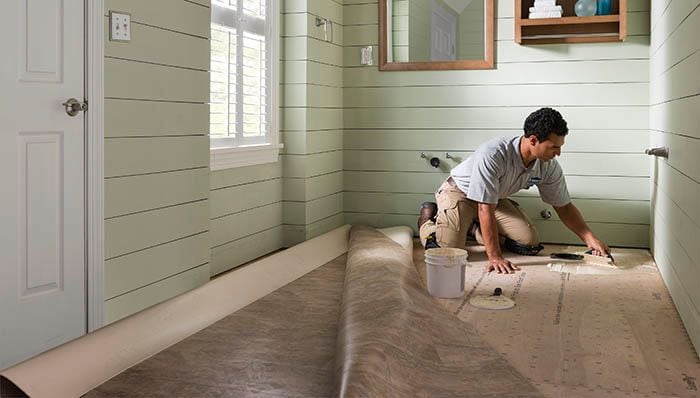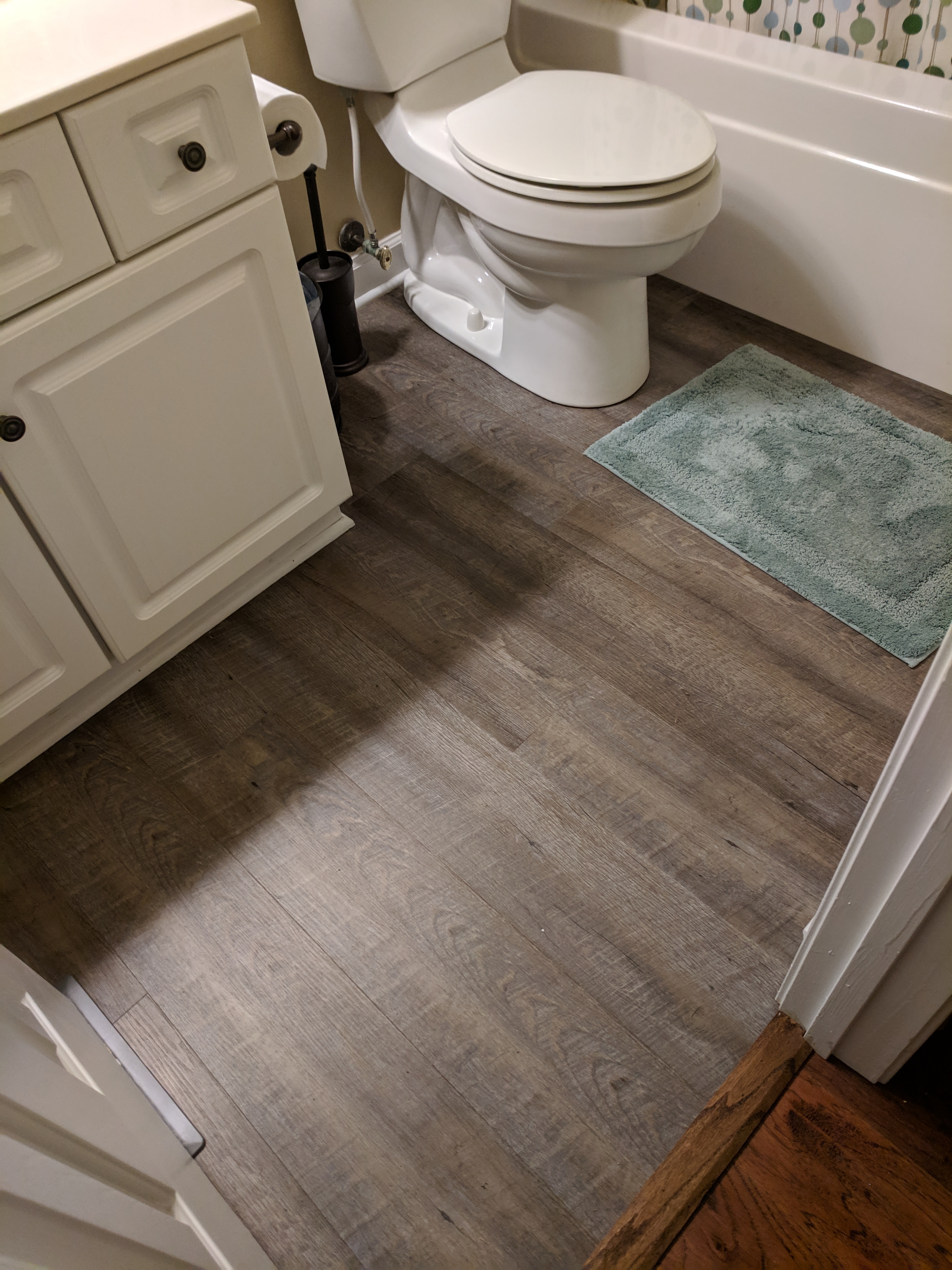Picture this: you’re finally ready to revamp your bathroom, but the budget is tight. You envision sleek, modern floors, but hardwood or tile seem like pipe dreams. Then, you discover vinyl flooring – stylish, durable, and surprisingly affordable. But how much will it really cost to install vinyl flooring in your bathroom? We’re diving deep into the world of bathroom vinyl, uncovering the factors that influence the cost and equipping you with the knowledge to make informed decisions.

Image: mromavolley.com
So, you’re ready to upgrade your bathroom with vinyl flooring. But with so many variables, it’s natural to wonder: how much will it REALLY cost? Let’s break it down.
The Variables that Shape your Bathroom Vinyl Flooring Cost
The cost of vinyl flooring installation isn’t a one-size-fits-all situation. It’s like a jigsaw puzzle, with each piece contributing to the overall picture. Here are the key elements that influence the price tag:
1. Vinyl Flooring Type:
- Luxury Vinyl Plank (LVP): Mimicking the look of hardwood, LVP offers durability and beauty. Its price range can be quite diverse, varying from $3 to $10 per square foot depending on the brand, thickness, and features like waterproof protection or realistic wood textures.
- Vinyl Sheet Flooring: This classic option is known for its affordability and ease of installation. It’s available for $1 to $4 per square foot, typically featuring a solid color or pattern, though some newer options offer realistic tile or stone designs.
- Vinyl Tile Flooring: Offering a versatile aesthetic, vinyl tiles can mimic wood, stone, or even mosaic layouts. They range from $2 to $5 per square foot, often featuring more texture than sheet vinyl.
2. The Size of Your Bathroom:
The bigger the bathroom, the more flooring you’ll need, and the higher the overall cost. A modest 5′ x 8′ bathroom will require significantly less flooring than a spacious 10′ x 12′ bathroom, impacting the bottom line.
3. Labor Costs:
Hiring professional installers can be a worthwhile investment. They bring expertise, speed, and ensure a seamless finish. However, their fees vary depending on location, experience, and the complexity of the installation. Expect labor costs to range from $3 to $6 per square foot.
4. Underlayment:
While not always necessary, underlayment can significantly enhance the comfort and longevity of your vinyl flooring. It acts as a cushioning layer, reducing noise and making the floor warmer to walk on. Underlayment costs vary, starting from $0.50 to $2 per square foot, depending on material and thickness.
5. Existing Subfloor Condition:
Your existing subfloor condition plays a crucial role. If it’s uneven or damaged, it might require repairs or leveling, adding an extra cost. It’s wise to assess the subfloor before diving into installation to avoid surprises.
6. Removal of Existing Flooring:
If you’re replacing an existing floor, removing it will add to the overall cost. This can vary greatly based on the existing flooring type, whether it’s tile, wood, or even old vinyl that’s glued down.
7. Additional Costs:
Beyond the core materials, consider these aspects:
- Trim and Molding: For a polished look, you might need trim and molding, especially if transitioning to a different floor type in your home.
- Transition Strips: These are essential for seamless transitions between flooring types.
- Door Thresholds: If your existing door thresholds need to be altered or replaced due to the floor installation, you’ll need to factor in the cost.
Getting a Realistic Estimate of the Cost
So, how do you get a tangible idea of the final cost? Here’s a practical approach:
-
Measure Your Bathroom: Accurately measure the area to be covered with vinyl flooring, taking into account any recesses or areas not requiring flooring, as these will impact the square footage needed.
-
Shop Around for Materials: Research different vinyl flooring options and compare prices from local retailers or online stores.
-
Get Quotes from Contractors: Contact several reputable contractors in your area, providing them with your measurements and flooring choices. Be sure to ask for detailed quotes that specify labor costs, materials, and any additional fees like demolition or subfloor repair.
Tips for Saving Money on Vinyl Flooring Installation
Everyone loves a good deal! Here are some tips to keep costs in check:
- Consider DIY Installation: If you’re handy and willing to invest time, you can attempt DIY vinyl installation, potentially saving on labor costs. However, this requires precise measurements, a steady hand, and a thorough understanding of the installation process.
- Choose More Affordable Vinyl Options: Sheet vinyl offers a cost-effective choice compared to luxury vinyl plank (LVP). Consider the style and durability level you truly need, rather than focusing solely on the highest-end options.
- Shop Around for Deals: Check for sales and promotions at local flooring stores or online retailers, and compare prices to find the best deals on materials.
- Plan Your Installation During Off-Seasons: Contractors tend to offer better rates during off-seasons, so consider scheduling your installation during the winter months when demand is lower.

Image: home.mybios.me
Protecting Your Investment with Proper Care
Once you’ve invested in your beautiful new vinyl flooring, it’s crucial to care for it properly to extend its lifespan. Here are some key tips:
- Regular Sweeping and Mopping: Sweep or vacuum regularly to remove dirt and debris. For regular cleaning, use a damp mop with a mild, pH-neutral cleaner. Avoid harsh chemicals like bleach or ammonia, as they can damage the flooring.
- Prevent Scratches: Place protective mats beneath heavy furniture and use furniture sliders to prevent scratches.
- Address Spills Promptly: Wipe up spills immediately to prevent stains or damage.
- Protect from Sun Exposure: Extended exposure to direct sunlight can fade vinyl flooring. Use blinds or curtains to help mitigate this issue.
Cost To Install Vinyl Flooring In Bathroom
Your Bathroom, Your Vision, Your Choices
Choosing vinyl flooring for your bathroom is a bright move – it’s stylish, durable, and often budget-friendly. Armed with this information, you can confidently navigate the cost landscape, select the right materials, and make informed decisions that transform your bathroom into a space you love. Remember, this is YOUR project, and you’re in charge. Take your time, research your options, and don’t hesitate to ask for expert advice along the way.





